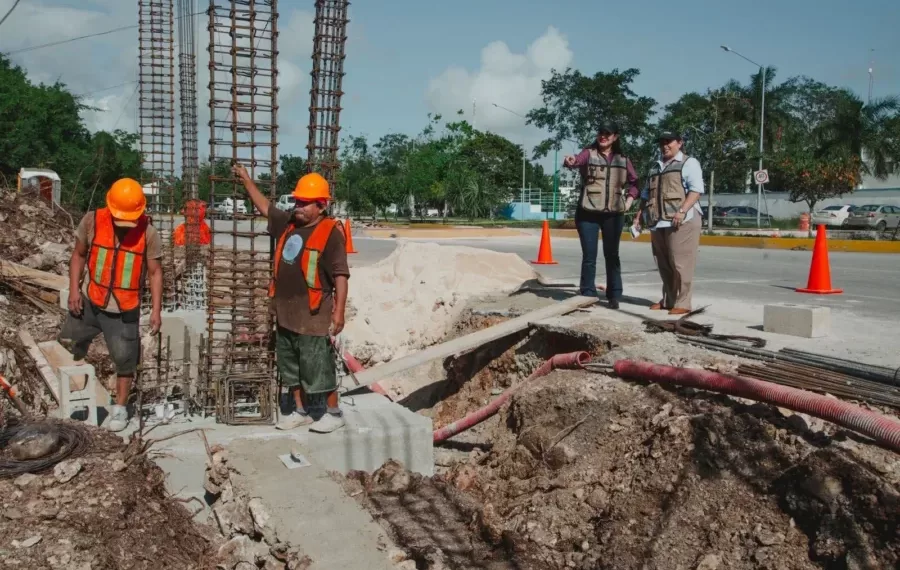Playa del Carmen, Mexico — Mayor Estefanía Mercado Asencio declared in her First Government Report that Playa del Carmen is currently experiencing the most significant public works transformation in its history. The announcement detailed a comprehensive effort to address decades of infrastructural neglect and to establish a new, unified civic identity for the city.
Addressing a Historic Backlog
Upon taking office, the municipal government inherited a city facing a severe historical deficit in infrastructure and public services, accumulated over more than two decades. Mayor Mercado described the initial state of the municipality: a collapsed garbage collection service with more than 28 trucks out of service, streets riddled with over 3,500 potholes, and a demoralized Public Services department lacking a proper dining facility, with deteriorated uniforms and tools in poor condition.
“How do we reduce the gap for a city that receives millions of people a year, with an infrastructure that had a backlog of at least more than 20 years?” questioned the mayor.
A Historic Investment in Public Works
Through financial discipline and resource optimization, the municipal administration executed a historic investment of 900 million pesos. This investment is reflected in 24 works already completed and delivered to the community, with an additional 18 projects nearing inauguration.
Key accomplishments include the recovery of essential parks such as Villas del Sol, Rayadores, Leona Vicario, Avenida 90 in El Pedregal, and the Civic Plaza of Puerto Aventuras. The rehabilitation of the Municipal Velatory, the CEBIAM Pet Sanctuary, and the Market on 10th Avenue were also carried out.
The administration also executed essential dredging work and constructed absorption wells to prevent flooding and improve residents' quality of life. The transformation includes improvements to main roadways with repaving, construction of sidewalks, curbs, and accessible pedestrian crossings designed to facilitate mobility for all, especially persons with disabilities. The construction of an arch at the northern entrance to the municipality was highlighted as a project that combines urban beautification with investment in security.
Public Services and Urban Cleaning
In the realm of public services, the mayor explained that the municipality was received with a garbage collection backlog exceeding 15 days. By putting 65 trucks equipped with GPS technology into operation, extending hours, and implementing contingency operations, the service was normalized within just 10 days. Playa del Carmen now has 93 active routes and has collected more than 200,000 tons of garbage in one year.
The municipal government also achieved significant advances in urban maintenance, including over 202 million square meters of manual and mechanical sweeping, 129 thousand linear meters of curb and median maintenance, over 9 million square meters of grass mowing, 721 maintenance actions in parks and domes, and the rehabilitation of 5,825 streetlights. These efforts have positioned Playa del Carmen among the best-rated cities in the country for public services.
Establishing a New Civic Identity with "Arena Playa"
In a parallel initiative, Mayor Mercado announced that a program will begin in 2026 to consolidate Playa del Carmen's identity through the application of the color "Arena Playa" (Beach Sand) to commercial establishments and homes. The color, approved by the City Council, aims to prevent future mayors from imposing a color alien to the inhabitants' identity.
“Just as we have worked tirelessly changing the face of the city, it was also fair to return to Playa del Carmen something equally valuable: a symbol of identity, a color that unites all of us in public space,” stated the mayor.
Mercado recalled that for many years the city was painted according to the colors of the political party in power, depriving residents of their own identity. “We received a city entirely painted blue, coincidentally the color of the governing party. What does the color of a political party have to do with our city?” she questioned.
The program was born from a participatory exercise with citizens that defined a color to represent them. “From that exercise, ‘Arena Playa’ was born,” she explained. Although the program will formally begin in 2026, the color is already being felt in the city, with 83 recovered parks and main pedestrian crossings and bridges painted in this tone.
The mayor emphasized that the objective is to create an urban symbol that does not divide, exclude, or respond to political interests, but rather identifies and fills all residents with pride. “The key to success for modern cities is to differentiate themselves and generate symbols that identify us in the world, like Santorini and Mykonos in Greece or Izamal in Yucatán,” she affirmed.
Mercado added that Playa del Carmen is already a global reference for its beaches, natural beauty, cenotes, and tourist services, and that this initiative seeks to also consolidate it as an example of modern and participatory urban image. “That dream today has a name: Arena Playa,” she concluded.
Finally, Mercado highlighted that these actions are aligned with broader strategies of urban planning and security. She cited the "broken windows theory" to explain that the care of parks, streets, and public spaces is not only aesthetic but also contributes to reducing crime rates, reinforcing that every intervention by her government is connected to the well-being and identity of the city.
“Today we can say with pride that Playa del Carmen lives the greatest transformation in public works in its history,” Mercado concluded to an ovation from attendees.
Discover more from Riviera Maya News & Events
Subscribe to get the latest posts sent to your email.
